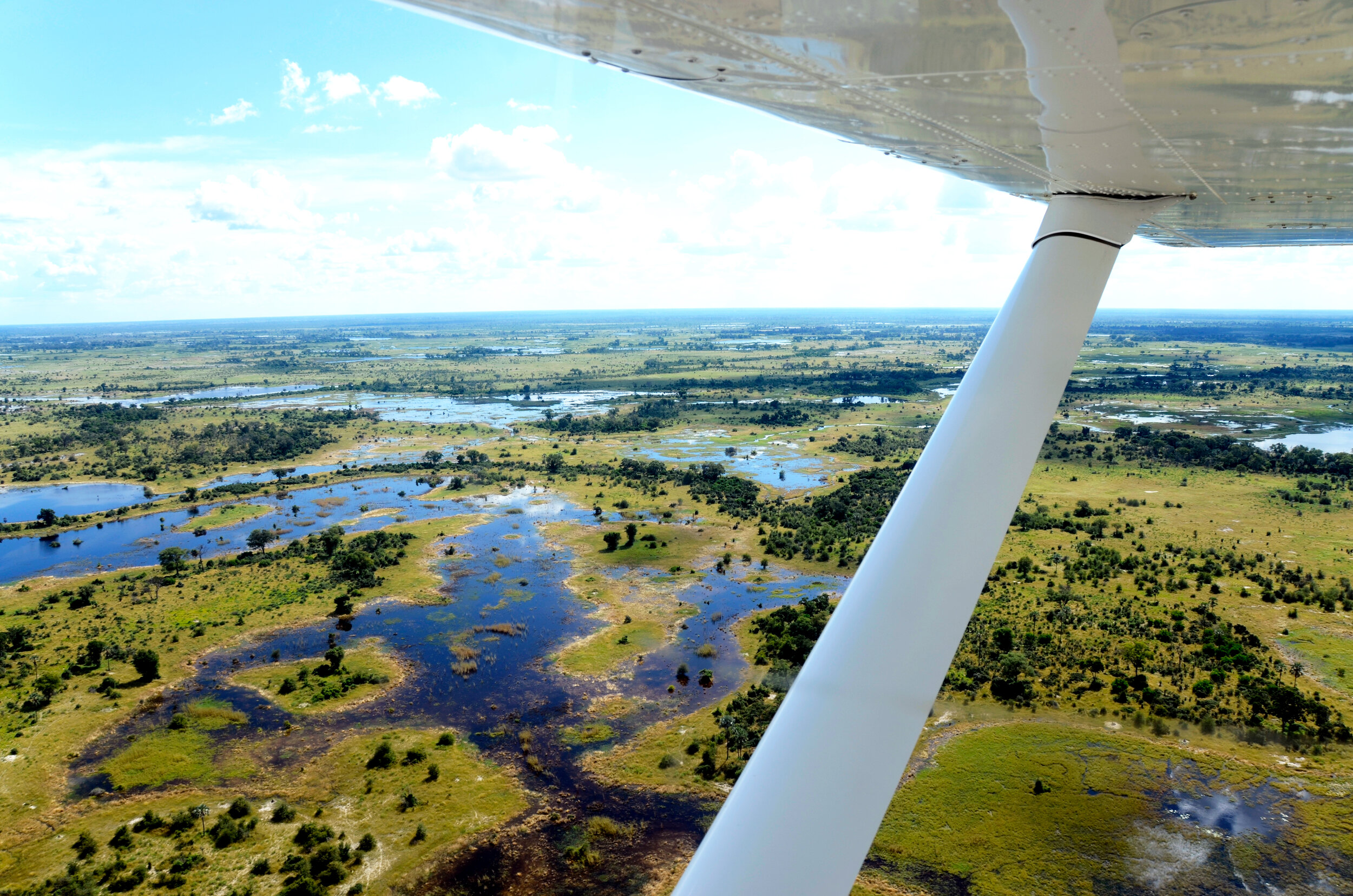
“The Okavango Delta is an astonishing sight: the great Okavango River, rather than flow towards the sea, flows inland, into the sands of the Kalahari.”
— Alexander McCall Smith
Exploring the Okavango Delta in Botswana
As we circled the dusty landing strip for the third time, the giraffe that was stood blocking the runway finally took notice of our tiny twelve seater propeller plane trying to land. As this magnificent creature started to move off the runway it disappeared, instantly becoming camouflaged into the thick green bush. Wow! Our first experience in the Okavango Delta was a sharp reminder that we were a visitor in this unknown land and these animals were certainly making it known this is what they call home.
The Delta has always fascinated us
The Okavango Delta is always somewhere we have been fascinated with, not just for the wildlife but the fact that this landlocked country has a fully active delta. For many people, it is unknown that, despite never reaching the sea, this rich water source flows inland from Angola, through Namibia, until finally reaching Botswana and the Okavango River. Once these areas flood, the water spills over the savanna plains into several channels which forms this unique and ever changing inland delta, an ideal breeding ground for an incredible diversity of wildlife.
Everything was so green
One of the most striking things about the Okavango was its immense greenery that stretches for miles on end. Even when travelling in a tiny ‘caravan’ plane, it is impossible to see where the swampy channels and endless green islands end and begin. When we looked down the tiny plane window, we still found it hard to wrap our head around the vastness of this magnificent natural phenomenon that can stretch to a staggering 22,000 kilometres in full flood. All the water that we had seen running for miles forms over 150,000 islands which range from just a few metres to over 10 kilometres in land mass and are home to thousands of species. As we got off the plane and walked to the open top safari vehicle, I was offered a cool drink which was welcomed after our short (30 minute) but very humid flight from Maun in the mid-morning, 27 degree heat.
Shinde Camp was magical
Shinde means ‘tree squirrel’ in Setswana and is the native language of Botswana. The camp was littered with them and everywhere we went there was usually one scurrying away from us. These cheeky little animals especially like to jump down from the branches, landing loudly in the blissfully quiet camp onto the top of the luxury canvas tents. The camp itself has a colonial and historical charm, offering 8 en suite traditional tents. Each large canvas covered room incorporates large double beds with fresh crisp linen, unique furniture styles and colours to provide an elegant safari feel in the remote African bush. At the front of each tent are wide glass doors leading onto the peaceful front decking that offer breathtaking views over the flat open flood pains or onto the swampy channels of the Delta. The truly magical thing about this lodge that sets it apart is the brilliant people who work here. From the guides to the cooks, the spirit and warmth of these people make you feel instantly at home and relaxed. It is clear from their attitude and generosity that not only do they love their jobs, they also wanted every visitor to have the most unforgettable experience.
An early start!
Each morning usually started with a cup of hot coffee sitting outside on the decking of our tent and overlooking the surroundings. Having this little treat delivered to your tent each morning, along with a few cheery words from one of the staff, made it a little easier to leave the comforts of your bed and stumble out onto your private deck. As we sat, listening to the morning birds chirping, the naughty tree squirrels were running and watching the sunrise lifting the mist off what seems like the never ending flood plain, we instantly forgot about our tiredness. We could feel the anticipation and excitement building at the thought of the day ahead of us as we knew that it was undoubtedly going to be an incredible day of game viewing.
The wildlife is astonishing
The morning game drive did not disappoint. It seemed like every corner we turned there was a new abundance of wildlife waiting for us. In just a few hours we were lucky enough to see a hippopotamus, elephant, zebra, hyena, giraffe, leopard and an endless amount of stunning birdlife. You can travel by motorboat to explore the winding channels filled with reeds, where crocodiles like to hide and hippos spend their days wallowing in the water. You can also go fishing where you can expect to catch species such as tilapia and tigerfish.
Exploring by Mokoro
The camp of course offers the traditional Mokoro boat rides which are a perfect way to travel around the channels without disturbing the wildlife. A Mokoro is a traditional boat in Botswana originally made out of the carved trunks of sausage, sycamore fig or jackal berry trees. However, in recent years these are being replaced by fibre glass models in an effort from the government to help conserve trees. The feeling of pure tranquillity when gliding through the water, with the boat making its path through the reeds and the African afternoon sun beating down, is something we will never forget and long to repeat for years to come. This is one of the best ways of getting up close to the incredible bird, plant and reptile species that live in this aquatic habitat of the Okavango Delta.
Botswana is a safari destination like no other
The guide’s extensive and astonishing amount of knowledge is simply mind blowing and without a doubt made the experience here more than we could of ever wished for. Botswana as a whole is a beautiful country that has so much to offer, from areas such as the central Kalahari to Chobe National Park and the Savuti Plains. However, Botswana is one of the most sought after safari destinations around the globe, which is undoubtedly down to this world famous inland delta and the vast variety of wildlife that live there. We were fortunate enough to have been able to visit this unique place; somewhere we will never forget and wish everybody had the opportunity to visit in their life.
Now, where to stay?
Shinde Camp - Rebuilt in 2020 and nestled on a lush palm island in the heart of the northern Okavango Delta, Shinde is an iconic camp located on the edge of the Shinde Lagoon, which is an area that simply teems with animal and birdlife.
Gunn's Main Camp - Overlooking the legendary Chief’s Island and bordering the Moremi Game Reserve, Gunn's Camp is a small tented camp set on raised platforms. The top deck boasts a large bar with magnificent views and the dining deck is on two separate levels. There is also a campfire boma, pool and lounge area.
Xigera (“kee-jera”) Safari Lodge - A wetland paradise in the Moremi Game Reserve of the Okavango Delta which recently opened in 2020. The lodge is surrounded by deep channels and lush vegetation within a remove area of the reserve. The lodge is small and intimate with only 12 suites meaning the service is top notch and every need it looked after. The lodge is also very eco friendly and its 100% solar powered with a dedicated focus on sustainability and eliminating single use plastics.












